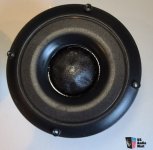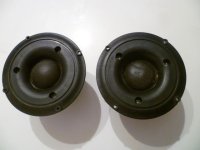I have a pair of Dynaudio D54 Midrange Domes that I have measured using DAT3 Version 3 and it looks like the Parameters / Impedance are off.
I am assuming the ferrofluid is dried up and requires replacement or removal.
There are 3 screws holding the front horn / faceplate to the magnet assembly. There are "push-pin" covers that "hide" these securing screws.
Is there a way to remove these covers without damaging / destroying them?
Let me know.
Thanks,
Dan
I am assuming the ferrofluid is dried up and requires replacement or removal.
There are 3 screws holding the front horn / faceplate to the magnet assembly. There are "push-pin" covers that "hide" these securing screws.
Is there a way to remove these covers without damaging / destroying them?
Let me know.
Thanks,
Dan
Attachments
Good question.
I have a NOS pair of D54 that is intended to be used on a pair of wooden Edgar midrange horns at some point.
I was going to just try them…take some DATS measurements.
Didn’t think I’d need to remove the faceplate to attach them to the horns.
I thought the same thing about the ferrofluid…but have not investigated.
I hadn’t even noticed “push pin” screw covers.
I guess if you can get the screws out and faceplate off it may be something similar to servicing the KEF T33 tweeters where an adhesive ring needs to be carefully cut free of the face of the magnet assembly and lifted off to access the coil gap?
I wonder if a big speaker service company with a lot of experience would be a hood resource for information?…The Speaker Exchange?
Maybe call asking about proper ferrofluid for them?…and tag the faceplate removal question on?
Do you already know what ferrofluid is supposed to be used?
EDIT: I wonder if you could use a small dowel as a handle and try some high strength double sided tape on the end? You should be able to peel it off and clean any residue afterwards.
I have a NOS pair of D54 that is intended to be used on a pair of wooden Edgar midrange horns at some point.
I was going to just try them…take some DATS measurements.
Didn’t think I’d need to remove the faceplate to attach them to the horns.
I thought the same thing about the ferrofluid…but have not investigated.
I hadn’t even noticed “push pin” screw covers.
I guess if you can get the screws out and faceplate off it may be something similar to servicing the KEF T33 tweeters where an adhesive ring needs to be carefully cut free of the face of the magnet assembly and lifted off to access the coil gap?
I wonder if a big speaker service company with a lot of experience would be a hood resource for information?…The Speaker Exchange?
Maybe call asking about proper ferrofluid for them?…and tag the faceplate removal question on?
Do you already know what ferrofluid is supposed to be used?
EDIT: I wonder if you could use a small dowel as a handle and try some high strength double sided tape on the end? You should be able to peel it off and clean any residue afterwards.
Last edited:
I have another pair of flat metal faced D54AF's that I took apart carefully other than I broke the wire (and resoldered) near negative terminal. I know next time what to do exactly to avoid this breakage. Previously before removing the ferrofluid, it had a jittery impedance curve with no obvious fs that DATS V3 could decipher and failed miserably in the "rub & buzz" test. So I cleaned all the viscuously-thick ferrofluid out and remeasured it and it was perfect with of course a higher impedance peak around 450Hz and passed the "rub & buzz" test .... the other unmodified 54AF measured good and passes the "rub & buzz" test easily. So eventually I will have a listening test between these 54AF's with or without ferrofluid to decide which direction to go. Since I will be going active, I don't need to worry about interaction between passive crossover and the resonant frequency impedance peak.....
Last edited:
I guess I can try that method..... these "plug" covers are wedged in there good btw...Good question.
I have a NOS pair of D54 that is intended to be used on a pair of wooden Edgar midrange horns at some point.
I was going to just try them…take some DATS measurements.
Didn’t think I’d need to remove the faceplate to attach them to the horns.
I thought the same thing about the ferrofluid…but have not investigated.
I hadn’t even noticed “push pin” screw covers.
I guess if you can get the screws out and faceplate off it may be something similar to servicing the KEF T33 tweeters where an adhesive ring needs to be carefully cut free of the face of the magnet assembly and lifted off to access the coil gap?
I wonder if a big speaker service company with a lot of experience would be a hood resource for information?…The Speaker Exchange?
Maybe call asking about proper ferrofluid for them?…and tag the faceplate removal question on?
Do you already know what ferrofluid is supposed to be used?
EDIT: I wonder if you could use a small dowel as a handle and try some high strength double sided tape on the end? You should be able to peel it off and clean any residue afterwards.
I’d look for something that is meant to hold on car trim or similar.
A plastic rod with a smooth end will hold better than a wood dowel.
You can clean the plug and rod surface with some rubbing alcohol first to make sure it sticks well.
If it comes out, and is hard to get off the rod, I’d soak it in the alcohol or or a citrus based “goo” remover.
So your intention then is to just get rid of any thickened ferrofluid and not replace it?
BTW…any picks you can take of the disassembly and pointers to avoid breaking wires etc would be greatly appreciated!
A plastic rod with a smooth end will hold better than a wood dowel.
You can clean the plug and rod surface with some rubbing alcohol first to make sure it sticks well.
If it comes out, and is hard to get off the rod, I’d soak it in the alcohol or or a citrus based “goo” remover.
So your intention then is to just get rid of any thickened ferrofluid and not replace it?
BTW…any picks you can take of the disassembly and pointers to avoid breaking wires etc would be greatly appreciated!
I opened my 4 (qty) Dynaudio D54 Mids tonight as I drilled a 1/32" hole in the screw cover and screwed in a small 1/32" eyehook and lifted the covers off. I do have 1/32" holes that I will fill in with a dab of black caulking to fill in the tiny hole.
Anyways I removed all the ferrofluid from these mids. There was a ton of ferrofluid and some was starting to dry up a bit based on the DATS V3 readings and "buzz & rub" failures.
So after all 4 were measured much more consistently with more realistic fs ( 340-425 Hz) with higher impedance peak (over 10ohms) at fs.
Learnings: No real mishaps while I was performing the 4 ferrofluid removals....
You will need to be careful as you separate the voice-coil/dome from the top of the magnet which has an adhesive to hold it in place. I used a putty knife and went slowly around the perimeter.
The 2 terminals and connections to the voice-coil leads are fairly fragile as you will have to scrape the foam /solder termination from the top of the magnet to enable the dome to be removed.
I guess you could de-solder the termination on top of the foam terminal base but I had full success without damaging the voice-coil leads.
Anyways I removed all the ferrofluid from these mids. There was a ton of ferrofluid and some was starting to dry up a bit based on the DATS V3 readings and "buzz & rub" failures.
So after all 4 were measured much more consistently with more realistic fs ( 340-425 Hz) with higher impedance peak (over 10ohms) at fs.
Learnings: No real mishaps while I was performing the 4 ferrofluid removals....
You will need to be careful as you separate the voice-coil/dome from the top of the magnet which has an adhesive to hold it in place. I used a putty knife and went slowly around the perimeter.
The 2 terminals and connections to the voice-coil leads are fairly fragile as you will have to scrape the foam /solder termination from the top of the magnet to enable the dome to be removed.
I guess you could de-solder the termination on top of the foam terminal base but I had full success without damaging the voice-coil leads.

